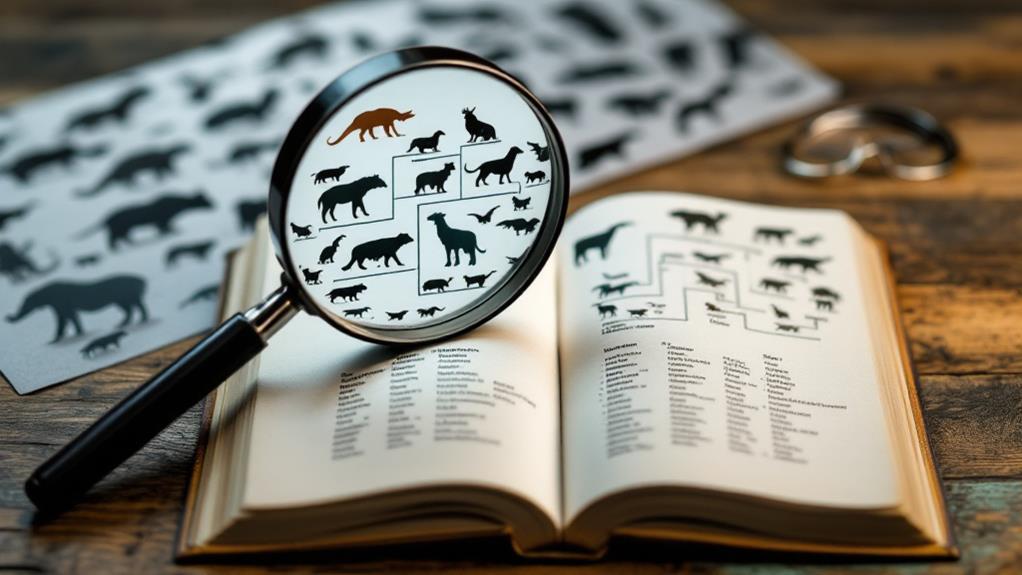Zoological nomenclature rules provide a standardized system for naming animal species. You'll find that binomial nomenclature, using genus and species names, forms the foundation. Type specimens serve as reference points for species identification, while priority and validity guarantee consistent naming. Taxonomic ranks help classify organisms, and specific rules govern how to name genera and species. The process for amending and revising names involves careful review and approval procedures. Understanding these rules is vital for scientists, researchers, and anyone interested in animal taxonomy. Exploring further will reveal the intricacies of this complex but essential system.
The Principle of Binomial Nomenclature

The cornerstone of modern species classification, binomial nomenclature is a standardized system for naming organisms. When you encounter scientific names, you'll notice they consist of two parts: the genus and the specific epithet. This system, developed by Carl Linnaeus in the 18th century, provides a universal language for scientists to communicate about species across languages and cultures.
You'll find that the genus name always comes first and is capitalized, while the specific epithet follows and is lowercase. For example, in Homo sapiens (modern humans), "Homo" is the genus, and "sapiens" is the specific epithet. It's essential to italicize or underline both parts when writing them.
You should know that this system offers several advantages. It eliminates confusion caused by common names, which can vary by region or language. It also reveals relationships between species; organisms in the same genus are closely related. For instance, you can immediately recognize that Canis lupus (gray wolf) and Canis latrans (coyote) are related species within the Canis genus.
When you're working with scientific literature, you'll often see the author's name and year of publication following the binomial name. This information helps trace the origin of the species description. Remember, the first valid publication of a species name takes precedence, following the Principle of Priority in zoological nomenclature.
As you explore deeper into taxonomy, you'll discover that binomial nomenclature extends to subspecies with a trinomial name. In these cases, you'll add a third term after the specific epithet to denote the subspecies.
Type Specimens and Their Importance
Establishing a concrete reference point for species identification, type specimens play an important role in zoological nomenclature. These physical examples serve as the standard against which all other specimens are compared, ensuring consistency in species classification.
When you're dealing with type specimens, you'll encounter several categories. The holotype is the single specimen designated by the author as the name-bearing type. It's the most significant reference for a species. If the holotype is lost or destroyed, a neotype can be designated to replace it.
You'll also find paratypes, which are additional specimens used in the original description. These support the holotype and help demonstrate variation within the species. Syntypes are a set of specimens used when no holotype was designated, while lectotypes are later selections from a group of syntypes to serve as the primary type specimen.
Type specimens are essential for resolving taxonomic disputes. When you're unsure about a species' identity, you can compare your specimen to the type to make an accurate determination. They're also important for maintaining nomenclatural stability, as they provide a fixed point of reference for each species name.
You'll find type specimens preserved in natural history museums and other scientific institutions. These collections are carefully maintained and made available to researchers for study. As technology advances, you'll see more digitized type specimens, allowing for easier access and comparison without risking damage to the original specimens.
Priority and Validity in Naming

While type specimens provide a physical reference for species, priority and validity in naming establish the rules for assigning and using scientific names. These principles guarantee that each organism has a unique, stable name recognized by the scientific community.
Priority refers to the rule that the first published name for a taxon takes precedence over later names. You'll find this principle essential in resolving naming disputes. If two scientists independently describe the same species, the name published first becomes the valid name. This rule encourages prompt publication of discoveries and prevents unnecessary renaming.
Validity in naming requires that names comply with the International Code of Zoological Nomenclature (ICZN). You must follow specific guidelines when proposing a new name, including proper Latin formation, designation of type specimens, and publication in a peer-reviewed journal. Names that don't meet these criteria are considered invalid.
It's important to note that priority isn't absolute. In some cases, a widely used junior synonym (a later name) can be conserved if changing it would cause significant confusion. The ICZN can rule on these exceptions to maintain nomenclatural stability.
You'll also encounter the concept of availability in naming. An available name is one that meets all the ICZN requirements and can potentially become valid. However, not all available names are currently valid, as they may have been superseded by earlier names or declared invalid for other reasons.
Understanding priority and validity is essential for taxonomists and researchers working with biological classifications. These rules guarantee consistency and clarity in scientific communication about species and higher taxa.
Taxonomic Ranks and Classifications
Taxonomic ranks and classifications form the backbone of how we organize life on Earth. They provide a hierarchical system that helps you understand the relationships between different organisms. At the highest level, you'll find domains, which include Bacteria, Archaea, and Eukarya. Below these, you'll encounter kingdoms, phyla, classes, orders, families, genera, and species.
When you're working with zoological nomenclature, you'll primarily focus on the animal kingdom. Within this domain, you'll need to be familiar with the various ranks and how they relate to each other. For instance, the genus and species names together form the binomial nomenclature that uniquely identifies an organism.
You'll often encounter subspecies, which are divisions within a species. These are denoted by a trinomial name, adding a third term after the species name. It's essential to understand that while species names are italicized, higher taxonomic ranks are not.
As you explore deeper into zoological nomenclature, you'll discover that classifications can change. New research and genetic studies may lead to the reclassification of organisms. You'll need to stay updated on these changes, especially if you're working in fields like biology or ecology.
Remember that taxonomic ranks are not absolute. They're human constructs designed to help us understand and categorize the diversity of life. As you use these classifications, keep in mind that they're tools for organization and communication rather than rigid, unchangeable structures.
Rules for Genus and Species

Several key rules govern the naming of genus and species in zoological nomenclature. When you're working with scientific names, you'll need to follow these guidelines to guarantee clarity and consistency in taxonomic communication.
First, you must write the genus name with an initial capital letter, followed by the species name in lowercase. For example, "Homo sapiens" for humans. You'll always italicize or underline both names when typing or writing by hand, respectively.
The genus and species names should be in Latin or latinized forms. You can't use abbreviations, except for the genus name after its first mention in a text. For instance, you can write "H. sapiens" after initially using "Homo sapiens."
When you're naming a new species, you must provide a clear description and designate a type specimen. This specimen serves as the reference point for the species. You'll need to publish the new name in a recognized scientific publication to make it valid.
Remember that the same genus name can't be used for different animal groups, even across different kingdoms. However, you can use identical species names in different genera.
If you're revising taxonomic classifications, you must adhere to the Principle of Priority. This rule states that the oldest validly published name takes precedence. You can't change names arbitrarily; there must be a scientific basis for any modifications.
Lastly, you should avoid using names that are offensive, tautonymous (repeating the genus name as the species name), or based on geographic terms that may change over time. By following these rules, you'll contribute to the standardization and clarity of zoological nomenclature.
Amendments and Revisions Process
The process of amending and revising zoological nomenclature is an ongoing task that guarantees scientific names remain accurate and up-to-date. As a researcher or taxonomist, you'll find that this process is vital for maintaining the integrity of zoological classification systems.
When you need to propose an amendment or revision to existing nomenclature, you'll need to follow specific procedures outlined by the International Commission on Zoological Nomenclature (ICZN). First, you'll submit a detailed proposal to the ICZN, explaining the reasons for the change and providing supporting evidence. This proposal should include thorough research, references to relevant literature, and a clear explanation of how the amendment will benefit the scientific community.
Once you've submitted your proposal, the ICZN will review it carefully. They'll consider factors such as the stability of nomenclature, potential confusion that might arise from the change, and the overall impact on zoological taxonomy. If your proposal is accepted, it'll be published in the Bulletin of Zoological Nomenclature for public comment.
During the comment period, other experts in the field can provide feedback on your proposed amendment. You'll need to address any concerns or criticisms raised during this time. After considering all input, the ICZN will make a final decision on whether to approve the amendment.
If approved, your revision will be officially adopted and published in the Official Lists and Indexes of Names in Zoology. It's significant to recognize that this process can be lengthy, often taking several months or even years to complete. However, it's essential for maintaining the accuracy and relevance of zoological nomenclature in the ever-evolving field of taxonomy.

Erzsebet Frey (Eli Frey) is an ecologist and online entrepreneur with a Master of Science in Ecology from the University of Belgrade. Originally from Serbia, she has lived in Sri Lanka since 2017. Eli has worked internationally in countries like Oman, Brazil, Germany, and Sri Lanka. In 2018, she expanded into SEO and blogging, completing courses from UC Davis and Edinburgh. Eli has founded multiple websites focused on biology, ecology, environmental science, sustainable and simple living, and outdoor activities. She enjoys creating nature and simple living videos on YouTube and participates in speleology, diving, and hiking.

